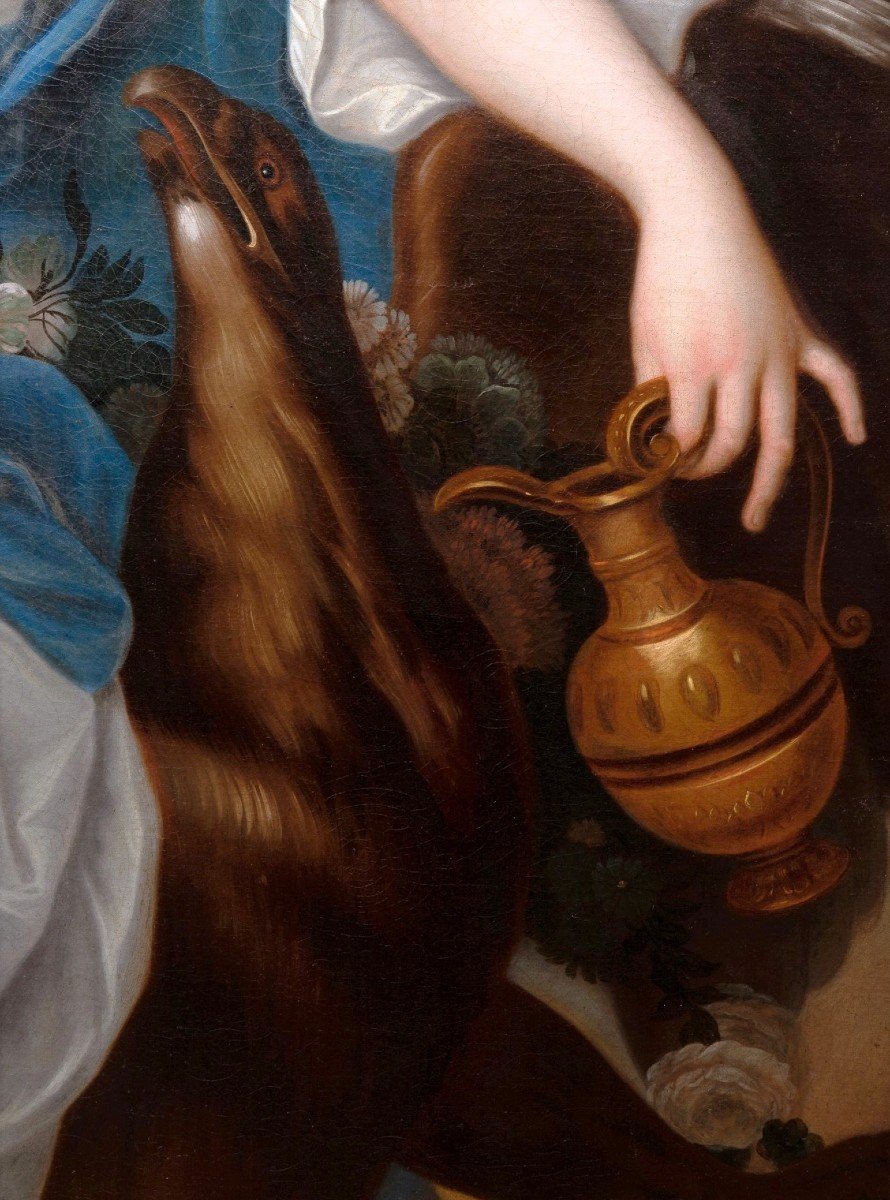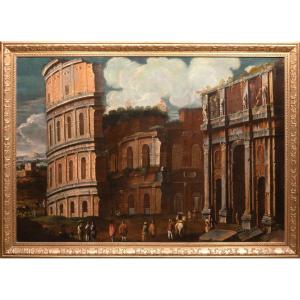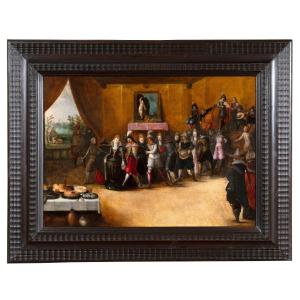"Portrait Of Princess Of Bourbon As Hebe, Pierre Gobert, Circa 1730"
Presumed portrait of Elisabeth Thérèse Alexandrine de Bourbon-Condé, Mademoiselle de Sens, depicted as the goddess Hebe kidnapped by Zeus, transformed into an eagle.18th century French School, around 1730
Pierre Gobert (1662-1744) and workshop
Oil on canvas
Dimensions: canvas: h. 129 cm, w. 95cm
Dimensions: framed: h. 156 cm, w. 124cm
Louis XIV style giltwood and cardved wood frame
Large and imposing portrait of the young princess portrayed seated on an eagle in the heavens.
Seen from the front, the princess is dressed in a low-cut white chiffon dress, exposing her throat.
Delicately made-up oval face, dominated by large blue-gray eyes is surrounded by powdered hair, raised, releasing the forehead and the ears, and of which some locks fall on his shoulder.
A large blue scarf passed over the shoulder covers her knees and flies in the wind. A garland of flowers coming from the back goes over the knees and down again on the eagle.
In her right hand she holds a golden goblet and in her left hand an ewer.
The eagle supporting the young woman seizes in its claws the thunderbolt (the beam of fiery lightning), the attribute of Zeus.
The figure of the young woman is enlivened by the fluidity of the antique drapes, while the luminous brilliance of the flesh and the white muslin contrasts with the singularly twilight background.
The tight fabrics accentuate the natural sensuality of the young woman while the choice of the goddess Hebe is traditionally favored to enhance the youth of the model.
Pierre Gobert works mainly for the courts of Versailles, Lorraine and Monaco.
He painted mostly women and children (which is a rarity for the time).
By disguising ladies as Hébé, Venus, Iris and other ancient deities, he followed the trend established by Louis XIV for the so-called historical portrait. Far from the heavy fabrics of conventional ceremonial portraits, he dresses his heroines in light antique fabrics and often presents them natural without jewels with only flowers as ornament.
Related works by Pierre Gobert of Women as Hebe:
• Portrait as Hébé of Charlotte-Aglaé d'Orléans, Duchess of Modena, as Hébé, circa 1720, Palace of Versailles
• Portrait as Hébé of Madame Savari?, Nymphnebourg Palace, Munich, Germany
• Portrait as Hébé of Princess de Craon, Sotheby's Paris, 09/15/2017, from the Collection of Prince Marc de Beauvau-Craon
In Greek mythology, Hebe, daughter of Zeus and Hera, is a goddess personifying the youth, vitality and vigor of youth. She serves as cupbearer to the gods by serving them nectar.
Pierre Gobert (1662-1744)
Son of Jean Gobert, sculptor to the King, grandson of Jean Gobert the eldest, carpenter sculptor, brother of Jean Gobert, known as the "ordinary painter to the King" Pierre Gobert was born in Paris or Fontainebleau in 1662. Perhaps trained in contact with Claude Lefèvre, he would have worked from 1679 for the court of Bavaria, making the portrait of Marie-Anne, future Dauphine of France. Renewing her confidence in the artist, she commissioned a portrait of her son the Duke of Burgundy from Versailles in 1682. Received at the Academy of Painting on September 24, 1701, with the portraits of Corneille van Clève and Bon Boullogne, Pierre Gobert exhibited fifteen portraits at the Salon of 1704, and demonstrated his privileged access to the court: among these portraits were that of the Duchess of Maine and the little Duke of Brittany, the future Louis XV. Thanks to this reputation, and no doubt thanks to the intervention of Elisabeth-Charlotte, Gobert was approached by the Court of Lorraine in 1707, in order to paint the portrait of the Dukes of Lorraine, Elisabeth-Charlotte of Orléans and the four princesses. It is likely that Gobert developed a studio during this period, since he seems to have operated back and forth between Paris and Lorraine, and even had portraits sent from Paris. Gobert thus obtained the title of ordinary painter of the Duke of Lorraine, and continued to deliver portraits to the court, notably in 1719 and 1721. He thus participated in the artistic influence of the court of Lunéville, which sought to be part of the wake of Versailles.
Back in Paris, on the strength of this prestigious introduction, which he took advantage of by bearing the title of “ordinary painter to the Duke of Lorraine”, Gobert then worked for the Condés and the Contis, and for the Prince-Elector Max Emmanuel of Bavaria. In 1737, the painter shone for the last time by presenting at the Salon one of his most ambitious portraits, that of the family of the Duke of Valentinois (Monaco, prince's palace). By the choice of his somewhat fixed attitudes, by the affected and graceful disposition of the fingers of his female models, by the use of historical travesties, by the depersonalized and flattering type of his resolutely placid faces, Gobert had managed to create thanks to his relentless and recognized work, a style which contrasted with the works of Largillierre and Rigaud, his contemporaries.
Elisabeth Thérèse Alexandrine de Bourbon-Condé, born in Paris on September 16, 1705 and died in Paris on April 15, 1765, was a princess of the blood and the daughter of Prince Louis III of Bourbon-Condé. His father was the grandson of the Grand Condé and his mother, Louise-Françoise de Bourbon, Mademoiselle de Nantes, was one of the legitimized daughters that Louis XIV had had by his favourite, Madame de Montespan.



















































 Le Magazine
Le Magazine Rivista Artiquariato
Rivista Artiquariato TRÉSORS magazine
TRÉSORS magazine